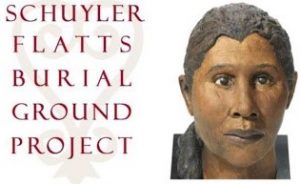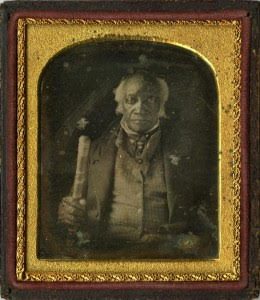
In White Plains, near where I live, there is annual Juneteenth parade and festival to commemorate the legal end of slavery in the United States. It is a community effort in recognition of June 19th, 1865, when Union soldiers, led by Major General Gordon Granger, landed at Galveston, Texas with news that the war had ended and slavery was over. That date certainly has earned its own place in history but it was almost 40 years earlier on July 4, 1827, when slavery legally ended in New York based on a law passed in 1799. The home of John Jay, founder of the New-York Society for Promoting the Manumission of Slaves, was located in Rye near where the first slaves in Westchester landed. They were then transported across the county to the Philipsburg Manor to the area at the east end of the Tappan Zee Bridge. Undoubtedly that journey passed through White Plains near Main Street where the Juneteenth celebration was held.
There were slaves in New Amsterdam as early as 1626, scarcely after there was a New Amsterdam. This means that New Amsterdam/New York had about a two century history of slavery that is not commemorated. The Women’s Suffrage Centennial in 2017 in New York recognizes that women received the right to vote two years here prior to the national action. By contrast the earlier abolishment of slavery in the state versus the country passes almost unnoticed. This year, in part due to the initiation of the Lower Manhattan Historical Society (I am on the Board), there will be an interfaith and interracial ceremony on July 4 at the John Street Methodist Church commemorating the ending of slavery in New York just as that Church did on July 4, 1827, a day marked by a parade in celebration.
Two centuries of history are being lost in the shuffle admittedly in the shadow of spectacular fireworks, music, and barbecues. That history has not completely disappeared but locating it takes effort.
Perhaps the foremost example occurred with the discovery of what is now the African Burial Ground National Monument which also conducts a Juneteenth commemoration. The over 6-acre site in use from the 1690s for about a century to 1794 was not lost but was thought destroyed. It was presumed that the perpetual construction in New York had obliterated the cemetery. Buildings at the site had basements to a depth of 20 feet. As it turns out, the ground level of Manhattan had increased even more so the constructions had not reached the burial ground until inadvertently and unexpectedly a new Federal project dug even deeper revealing it. The burial ground is now operated by the NPS but in part due to security restrictions in a working Federal office building, attendance beyond school groups, has not been what was hoped for.
These slaves in New Amsterdam helped build the famous wall at Wall Street just south of where the burial ground outside the city proper.
Speaking of Wall Street, it was at the east end of the street between Pearl and Water Streets that a slave market was established by a Common Council of the City of New York on November 30, 1711. It remained in use until 1762. The City installed a marker there in 2015 in recognition of that part of its history. Recent discoveries have revealed slave burial grounds in Hunts Park in the Bronx and Dutch Harlem now 124th-127th Street in Manhattan. For a long period of time the slave market and slave ownership in New York were second only to Charleston and South Carolina among the 13 colonies.

On Wall Street: Slavery Lost, Found, and Remembered: Pearl Duncan, July 7, 2015
All was not quiet on the northern front either. When I brought teachers to Philipsburg Manor as part of my Teacherhostels/Historyhostels, we would be shown examples of ads for runaway slaves in the North from colonial times long before the development of the Underground Railroad from the South. Recently Historic Hudson Valley which operates Philipsburg Manor received a 3-year NEH grant to develop exhibitions there interpreting the history of slavery in the North.
Along similar lines, Cornell University has initiated a project “Freedom on the Move” (FOTM), to compile all North American runaway slave advertisements, north and south, into a collaborative database of information. The project will allow partner institutions to add their own archives (example below).

As an example that all was not sweetness and nice with kindly northern masters, consider the title and description of Jill Lepore‘s book New York Burning: Liberty, Slavery, and Conspiracy in Eighteenth-Century Manhattan. Over a few frigid weeks in the winter of 1741, ten fires blazed across Manhattan. With each new fire, panicked whites saw more evidence of a slave uprising. In the end, thirteen black men were burned at the stake, seventeen were hanged, and more than one hundred black men and women were thrown into a dungeon beneath City Hall….The threat of black rebellion unite the white political pluralities in a frenzy of racial fear and violence.
Although New York’s two centuries of slavery doesn’t get the attention of the Underground Railroad, the northern slavery story is garnering more attention. For example, at the Crailo State Historic Site in Rensselaer, a new exhibit, A Dishonorable Trade: Human Trafficking in the Dutch Atlantic World, focuses on the Dutch slave trade in the seventeenth century. The exhibit explores the interconnectedness of the African, Caribbean, South American, North American and European trade networks of the Dutch West India Company and highlights the activity between Curacao and New Netherland. New Amsterdam and the van Rensselaer family are another focus of the exhibit. It is supported by the Gilder Lehrman Center for the Study of Slavery, Abolition and Resistance and an immersive study session at the Yale Public History Institute of Yale University for the Crailo staff.
Ironically, Heidi Hill, the Crailo site manager, also supervises nearby Schuyler Mansion in Albany. The Schuylers were slave owner just as the van Rensselaer’s were. There slave ownership might have made for some interesting conversations when Alexander Hamilton, of the same Manumission Society founded by John Jay his Federalist Papers colleague, married into the Schuyler family. I don’t recall those dinner discussions from the play “Hamilton.”
In fact, the Schuylers have been making news regarding their slaves. On June 5th, 2005, construction work in the Town of Colonie, near the Albany Rural Cemetery, revealed an unmarked burial ground. Archaeologists discovered 13 sets of remains plus another set of remains was found in 1998. A total of 14 individuals were discovered. I contacted the NYS Museum archaeologists conducting the dig about including a visit to the site as part of Teacherhostel/Historyhostel. However there was nothing really to see there then, not even a sign marking the site.
The burial ground was dated between the 1700s and early 1800s. Historical research indicates that the burial ground was part of the large Schuyler estate.

The Museum subsequently completed a bioarchaeological analysis. It determined that the remains are about 200 years old and represent 6 women, 1 man, 2 children, and five infants. DNA analysis concluded that four of the individuals are of West/East and Central African descent Two sets of remains are descendants of women from Madagascar. The Schuyler Flatts Burial Ground Project Committee is in the process of planning and implementing a ceremony at St Agnes Cemetery located in Menands, on Saturday, June 18th 2016.
Slavery lived on in New York past the July 4, 1827 deadline. In the spring of 1811, the Albany Common Council banned Pinkster Day celebrations because of “rioting and drunkenness.” Two centuries later, in an effort to revive a tradition from Albany’s past, members of the University Club petitioned the Common Council to repeal the prohibition. The Pinkster ban was lifted on May 16, 2011. For the celebration this year, the University Club welcomed author Scott Christianson on June 3. He discussed New York’s history of slavery and abolitionism through the life of a man known only as “Caesar.” He lived his entire life on a colonial estate in Albany County, and is believed to be the last person in New York to die in bondage in 1852. Caesar is buried in the cemetery of the Nicoll-Sill House in Bethlehem.

Sometimes history isn’t simply forgotten, it is erased. A recent article in American Interest recounted Putin’s efforts to rewrite Russian history to legitimate his actions in the present. The more famous example of erasure is China’s relentless censure of the massacre of June 4, 1989, at Tiananmen Square. The wouldbe superpower lives in mortal fear of Google, Facebook, the New York Times and the people learning the truth. Here in New York we don’t need to worry about our state government erasing the past, we’ll do it ourselves. Why remember the dark side of our heritage when we can celebrate how morally superior white people helped liberate oppressed people of color from subhuman Confederates? That’s certainly a story better worth telling over and over again.





